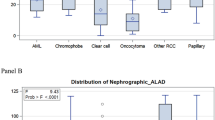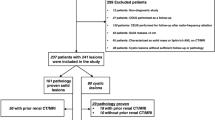Abstract
Objective
To evaluate whether the Aorta-Lesion-Attenuation-Difference on contrast-enhanced CT can aid in the differentiation of malignant and benign oncocytic renal neoplasms.
Materials and methods
Two independent cohorts—an initial (biopsy) dataset and a validation (surgical) dataset—with oncocytomas and chromophobe renal cell carcinomas (chRCC) were included in this IRB-approved retrospective study. A region of interest was placed on the renal mass and abdominal aorta on the same CT image slice to calculate an Aorta-Lesion-Attenuation-Difference (ALAD). ROC curves were plotted for different enhancement phases, and diagnostic performance of ALAD for differentiating chRCC from oncocytomas was calculated.
Results
Seventy-nine renal masses (56 oncocytomas, 23 chRCC) were analyzed in the initial (biopsy) dataset. Thirty-six renal masses (16 oncocytomas, 20 chRCC) were reviewed in the validation (surgical) cohort. ALAD showed a statistically significant difference between oncocytomas and chromophobes during the nephrographic phase (p < 0.001), early excretory phase (p < 0.001), and excretory phase (p = 0.029). The area under the ROC curve for the nephrographic phase was 1.00 (95% CI: 1.00–1.00) for the biopsy dataset and showed the narrowest confidence interval. At a threshold value of 25.5 HU, sensitivity was 100 (82.2%–100%) and specificity was 81.5 (61.9%–93.7%). When tested on the validation dataset on measurements made by an independent reader, the AUROC was 0.93 (95% CI: 0.84–1.00) with a sensitivity of 100 (80.0%–100%) and a specificity of 87.5 (60.4%–97.8%).
Conclusions
Nephrographic phase ALAD has potential to differentiate benign and malignant oncocytic renal neoplasms on contrast-enhanced CT if histologic evaluation on biopsy is indeterminate.



Similar content being viewed by others
References
Rodriguez-Rubio FI, Diez-Caballero F, Martin-Marquina A, Abad JI, Berian JM (1996) Incidentally detected renal cell carcinoma. Br J Urol 78:29–32
Ozen H, Colowick A, Freiha FS (1993) Incidentally discovered solid renal masses: what are they? Br J Urol 72:274–276
Homma Y, Kawabe K, Kitamura T, et al. (1995) Increased incidental detection and reduced mortality in renal cancer–recent retrospective analysis at eight institutions. Int J Urol 2:77–80
Jayson M, Sanders H (1998) Increased incidence of serendipitously discovered renal cell carcinoma. Urology 51:203–205
Thompson IM, Peek M (1988) Improvement in survival of patients with renal cell carcinoma–the role of the serendipitously detected tumor. J Urol 140:487–490
Duchene DA, Lotan Y, Cadeddu JA, Sagalowsky AI, Koeneman KS (2003) Histopathology of surgically managed renal tumors: analysis of a contemporary series. Urology 62:827–830
Frank I, Blute ML, Cheville JC, et al. (2003) Solid renal tumors: an analysis of pathological features related to tumor size. J Urol 170:2217–2220. doi:10.1097/01.ju.0000095475.12515.5e
Curry NS (1995) Small renal masses (lesions smaller than 3 cm): imaging evaluation and management. Am J Roentgenol 164:355–362. doi:10.2214/ajr.164.2.7839969
Motzer RJ, Bander NH, Nanus DM (1996) Renal-cell carcinoma. N Engl J Med 335:865–875. doi:10.1056/NEJM199609193351207
Lechevallier E, André M, Barriol D, et al. (2000) Fine-needle percutaneous biopsy of renal masses with helical CT guidance. Radiology 216:506–510. doi:10.1148/radiology.216.2.r00au01506
Richter F, Kasabian NG, Irwin RJJ, Watson RA, Lang EK (2000) Accuracy of diagnosis by guided biopsy of renal mass lesions classified indeterminate by imaging studies. Urology 55:348–352
Wood BJ, Khan MA, McGovern F, et al. (1999) Imaging guided biopsy of renal masses: indications, accuracy and impact on clinical management. J Urol 161:1470–1474
Hara I, Miyake H, Hara S, et al. (2001) Role of percutaneous image-guided biopsy in the evaluation of renal masses. Urol Int 67:199–202
Salem S, Ponsky LE, Abouassaly R, et al. (2012) Image-guided biopsy of small renal masses in the era of ablative therapies. Int J Urol . doi:10.1111/iju.12010
Schmidbauer J, Remzi M, Memarsadeghi M, et al. (2008) Diagnostic accuracy of computed tomography-guided percutaneous biopsy of renal masses. Eur Urol 53:1003–1011. doi:10.1016/j.eururo.2007.11.041
Silverman SG, Gan YU, Mortele KJ, Tuncali K, Cibas ES (2006) Renal masses in the adult patient: the role of percutaneous biopsy. Radiology 240:6–22. doi:10.1148/radiol.2401050061
Leveridge MJ, Finelli A, Kachura JR, et al. (2011) Outcomes of small renal mass needle core biopsy, nondiagnostic percutaneous biopsy, and the role of repeat biopsy. Eur Urol 60:578–584. doi:10.1016/j.eururo.2011.06.021
Volpe A, Kachura JR, Geddie WR, et al. (2007) Techniques, safety and accuracy of sampling of renal tumors by fine needle aspiration and core biopsy. J Urol 178:379–386. doi:10.1016/j.juro.2007.03.131
Pandharipande PV, Gervais DA, Hartman RI, et al. (2010) Renal mass biopsy to guide treatment decisions for small incidental renal tumors: a cost-effectiveness analysis. Radiology 256:836–846. doi:10.1148/radiol.10092013
Leão RRN, Richard PO, Jewett MAS (2015) Indications for biopsy and the current status of focal therapy for renal tumours. Transl Androl Urol 4:283–293. doi:10.3978/j.issn.2223-4683.2015.06.01
Jewett MAS, Finelli A (2014) Kidney cancer: routine small renal mass needle biopsy should be adopted. Nat Rev Urol 11:548–549. doi:10.1038/nrurol.2014.216
Blute ML, Drewry A, Abel EJ (2015) Percutaneous biopsy for risk stratification of renal masses. Ther Adv Urol 7:265–274. doi:10.1177/1756287215585273
Mally AD, Gayed B, Averch T, Davies B (2012) The current role of percutaneous biopsy of renal masses. Can J Urol 19:6243–6249
Phe V, Yates DR, Renard-Penna R, Cussenot O, Roupret M (2012) Is there a contemporary role for percutaneous needle biopsy in the era of small renal masses? BJU Int 109:867–872. doi:10.1111/j.1464-410X.2011.10544.x
Wang R, Li AY, Wood DP (2011) The role of percutaneous renal biopsy in the management of small renal masses. Curr Urol Rep 12:18–23. doi:10.1007/s11934-010-0149-x
Beland MD, Mayo-Smith WW, Dupuy DE, Cronan JJ, DeLellis RA (2007) Diagnostic yield of 58 consecutive imaging-guided biopsies of solid renal masses: should we biopsy all that are indeterminate? Am J Roentgenol 188:792–797. doi:10.2214/AJR.06.0356
Heilbrun ME, Yu J, Smith KJ, et al. (2012) The cost-effectiveness of immediate treatment, percutaneous biopsy and active surveillance for the diagnosis of the small solid renal mass: evidence from a Markov model. J Urol 187:39–43. doi:10.1016/j.juro.2011.09.055
Liu J, Fanning CV (2001) Can renal oncocytomas be distinguished from renal cell carcinoma on fine-needle aspiration specimens? A study of conventional smears in conjunction with ancillary studies. Cancer 93:390–397
Johnson NB, Johnson MM, Selig MK, Nielsen GP (2010) Use of electron microscopy in core biopsy diagnosis of oncocytic renal tumors. Ultrastruct Pathol 34:189–194. doi:10.3109/01913121003725713
Ehsani L, Seth R, Bacopulos S, Seth A, Osunkoya AO (2013) BCA2 is differentially expressed in renal oncocytoma: an analysis of 158 renal neoplasms. Tumour Biol 34:787–791. doi:10.1007/s13277-012-0608-8
Kuroda N, Tanaka A, Ohe C, et al. (2012) Review of renal oncocytosis (multiple oncocytic lesions) with focus on clinical and pathobiological aspects. Histol Histopathol 27:1407–1412
Kuroda N, Toi M, Hiroi M, Enzan H (2003) Review of chromophobe renal cell carcinoma with focus on clinical and pathobiological aspects. Histol Histopathol 18:165–171
Peyronnet B, Seisen T, Oger E, et al. (2016) Comparison of 1800 robotic and open partial nephrectomies for renal tumors. Ann Surg Oncol 23:4277–4283. doi:10.1245/s10434-016-5411-0
Sahni VA, Silverman SG (2009) Biopsy of renal masses: when and why. Cancer Imaging 9:44–55. doi:10.1102/1470-7330.2009.0005
Kuroda N, Toi M, Yamamoto M, et al. (2004) Immunohistochemical identification of intracytoplasmic lumens by cytokeratin typing may differentiate renal oncocytomas from chromophobe renal cell carcinomas. Histol Histopathol 19:23–28
Perez-Ordonez B, Hamed G, Campbell S, et al. (1997) Renal oncocytoma: a clinicopathologic study of 70 cases. Am J Surg Pathol 21:871–883
Amin MB, Crotty TB, Tickoo SK, Farrow GM (1997) Renal oncocytoma: a reappraisal of morphologic features with clinicopathologic findings in 80 cases. Am J Surg Pathol 21:1–12
Tickoo SK, Amin MB (1998) Discriminant nuclear features of renal oncocytoma and chromophobe renal cell carcinoma. Analysis of their potential utility in the differential diagnosis. Am J Clin Pathol 110:782–787
Ng KL, Rajandram R, Morais C, et al. (2014) Differentiation of oncocytoma from chromophobe renal cell carcinoma (RCC): can novel molecular biomarkers help solve an old problem? J Clin Pathol 67:97–104. doi:10.1136/jclinpath-2013-201895
Paño B, Macías N, Salvador R, et al. (2016) Usefulness of MDCT to differentiate between renal cell carcinoma and oncocytoma: development of a predictive model. Am J Roentgenol 206:764–774. doi:10.2214/AJR.15.14815
Bird VG, Kanagarajah P, Morillo G, et al. (2011) Differentiation of oncocytoma and renal cell carcinoma in small renal masses World J Urol 29:787–792. doi:10.1007/s00345-010-0586-7
Choi JH, Kim JW, Lee JY, et al. (2015) Comparison of computed tomography findings between renal oncocytomas and chromophobe renal cell carcinomas. Korean J Urol 56:695–702. doi:10.4111/kju.2015.56.10.695
Wu J, Zhu Q, Zhu W, Chen W, Wang S (2016) Comparative study of CT appearances in renal oncocytoma and chromophobe renal cell carcinoma. Acta Radiol 57:500–506. doi:10.1177/0284185115585035
Kim JI, Cho JY, Moon KC, Lee HJ, Kim SH (2009) Segmental enhancement inversion at biphasic multidetector CT: characteristic finding of small renal oncocytoma. Radiology 252:441–448. doi:10.1148/radiol.2522081180
Woo S, Cho JY, Kim SH, Kim SY (2013) Comparison of segmental enhancement inversion on biphasic MDCT between small renal oncocytomas and chromophobe renal cell carcinomas. Am J Roentgenol 201:598–604. doi:10.2214/AJR.12.10372
McGahan JP, Lamba R, Fisher J, et al. (2011) Is segmental enhancement inversion on enhanced biphasic MDCT a reliable sign for the noninvasive diagnosis of renal oncocytomas? Am J Roentgenol 197:W674–W679. doi:10.2214/AJR.11.6463
O’Malley ME, Tran P, Hanbidge A (2012) Small renal oncocytomas: is segmental enhancement inversion a characteristic finding at biphasic MDCT? Am J Roentgenol 199:1312–1315. doi:10.2214/AJR.12.8616
Schieda N, McInnes MDF, Cao L (2014) Diagnostic accuracy of segmental enhancement inversion for diagnosis of renal oncocytoma at biphasic contrast enhanced CT: systematic review. Eur Radiol 24:1421–1429. doi:10.1007/s00330-014-3147-4
Rosenkrantz AB, Hindman N, Fitzgerald EF, et al. (2010) MRI features of renal oncocytoma and chromophobe renal cell carcinoma. Am J Roentgenol 195:W421–W427. doi:10.2214/AJR.10.4718
Choudhary S, Rajesh A, Mayer NJ, Mulcahy KA, Haroon A (2009) Renal oncocytoma: cT features cannot reliably distinguish oncocytoma from other renal neoplasms. Clin Radiol 64:517–522. doi:10.1016/j.crad.2008.12.011
Author information
Authors and Affiliations
Corresponding author
Ethics declarations
Funding
No funding was received for this study.
Conflict of interest
The authors declare that they have no conflict of interest.
Ethical approval
All procedures performed in studies involving human participants were in accordance with the ethical standards of the institutional and/or national research committee and with the 1964 Helsinki declaration and its later amendments or comparable ethical standards. For this type of study formal consent is not required.
Informed consent
Statement of informed consent was not applicable since the manuscript was retrospective in nature and requirement for informed consent was waived by the IRB.
Rights and permissions
About this article
Cite this article
Dhyani, M., Grajo, J.R., Rodriguez, D. et al. Aorta-Lesion-Attenuation-Difference (ALAD) on contrast-enhanced CT: a potential imaging biomarker for differentiating malignant from benign oncocytic neoplasms. Abdom Radiol 42, 1734–1743 (2017). https://doi.org/10.1007/s00261-017-1061-3
Published:
Issue Date:
DOI: https://doi.org/10.1007/s00261-017-1061-3




